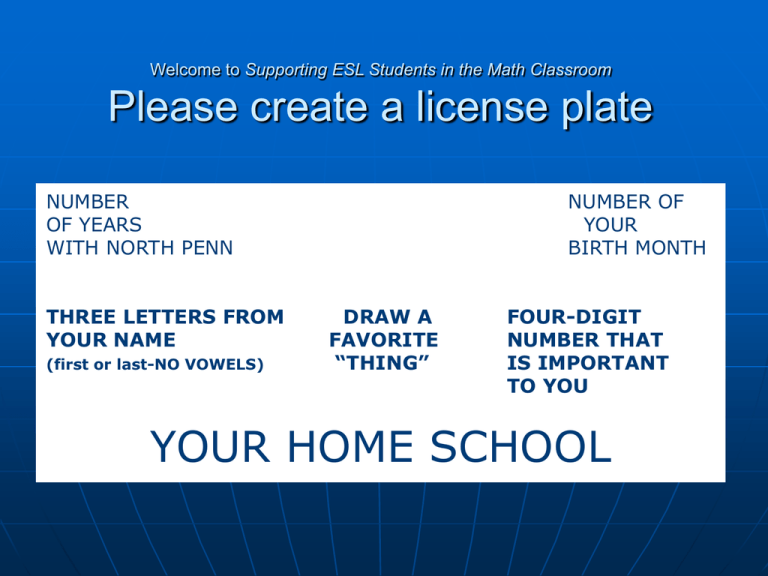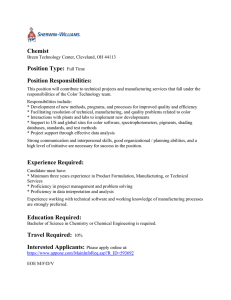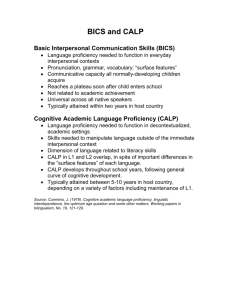Please create a license plate YOUR HOME SCHOOL NUMBER NUMBER OF
advertisement

Welcome to Supporting ESL Students in the Math Classroom Please create a license plate NUMBER OF YEARS WITH NORTH PENN THREE LETTERS FROM YOUR NAME (first or last-NO VOWELS) NUMBER OF YOUR BIRTH MONTH DRAW A FAVORITE “THING” FOUR-DIGIT NUMBER THAT IS IMPORTANT TO YOU YOUR HOME SCHOOL GLYPHS DATA REPRESENTED VISUALLY HOUSE SNOWMAN Roof Hat Door Buttons Windows Eyes Pet Fingers Flowers/clouds Snowflakes SUPPORTING ESL STUDENTS IN THE MATH CLASSROOM Nancy Kaufman kaufmna@npenn.org August 21, 2008 8:30-11:30 Bridle Path ±≠≤≥÷× Is math the universal language? Math is a language shared by all humans regardless of culture, religion, or gender. PI=3.14159 (∏) Math literacy is called numeracy. FIRST TO 100 1. ROLL TWO DICE 2. ADD THE DIGITS, RECORD THE SUM 3. PARTNER’S TURN TO ROLL AND RECORD 4. CONTINUE TAKING TURNS, ROLLING, RECORDING, ADDING UNTIL FIRST PERSON’S TOTAL IS 100 OR MORE (DOES NOT NEED TO BE EXACT) Stephen Krashen on SLA: AFFECTIVE FILTER: Low motivation, low selfesteem, and debilitating anxiety can combine to 'raise' the affective filter and form a 'mental block' that prevents comprehensible input from being used for acquisition. James Cummins on SLA: ICEBERG MODEL (???) (English) L1 L2 BICS BICS BICS 10% Basic Interpersonal Communication Skills 1-2 years CALP i+1 Second language acquisition takes place when student is exposed to 'Comprehensible Input' = 'i + 1'. CALP 90% Cognitive Academic Language Proficiency 5-7 years or 7-9 years if no L1 Lev Vygotsky's zone of proximal development English Language Proficiency Standard 1: English language learners communicate in English for SOCIAL AND INSTRUCTIONAL purposes within the school setting. English Language Proficiency Standard 2: English language learners communicate information, ideas,and concepts necessary for academic concepts necessary for academic success in the content area of LANGUAGE ARTS. English Language Proficiency Standard 3: English language learners communicate information, ideas,and concepts necessary for academic concepts necessary for academic success in the content area of MATHEMATICS. English Language Proficiency Standard 4: English language learners communicate information, ideas, and concepts necessary for academic concepts necessary for academic success in the content area of SCIENCE. English Language Proficiency Standard 5: English language learners communicate information, ideas, and concepts necessary for academic concepts necessary for academic success in the content area of SOCIAL STUDIES. The Language Domains Each of the five English language proficiency standards encompasses four language domains: listening, speaking, reading, and writing. The language domains reflect the language proficiency levels. The definitions of the language domains are as follows: Listening – process, understand, interpret, and evaluate spoken language in a variety of situations Speaking – engage in oral communication in a variety of situations for an array of purposes and audiences Reading – process, interpret, and evaluate written language, symbols and text with understanding and fluency Writing – engage in written communications in a variety of forms for an array of purposes and audiences The Language Proficiency Levels and Performance Definitions The five language proficiency levels outline the progression of language development implied in the acquisition of English as an additional language. 5 BRIDGING 4 EXPANDING 3 DEVELOPING 2 BEGINNING 1 ENTERING NORTH PENN SCHOOL DISTRICT 2007-2008 KOREAN Top 16 Languages (>10 students) BENGALI GUJARATI SPANISH-14 VIETNAMESE CHINESE HINDI CAMBODIAN EGYPTIAN RUSSIAN JAPANESE THAI URDU TAGALOG 2007-2008 ESL POPULATION FRENCH Over 60 languages from more than 50 countries TELUGU http://www.multimediapalace.com/wff/i/in-flag.htm CULTURE GRAMS http://culturegrams.com WORLD FACT BOOK https://www.cia.gov/library/publications/the-world-factbook/ If the World Were a Village by David J. Smith Pick your favorite 28 or 50 1776 or 1971 364 or 844 http://intranet.npenn.org/resources/timer.ppt OvalStickers.net TEACHING MATH TO ENGLISH LANGUAGE LEARNERS MAKE IT VISUAL MAKE THE INSTRUCTION HANDS-ON INTRODUCE NEW VOCABULARY AT THE BEGINNING OF A LESSON USE DIRECT INSTRUCTION USE GROUP-BASED WORK SIMPLIFY INSTRUCTIONS MAKE IT PERSONAL WHENEVER POSSIBLE, SUPPLEMENT A LESSON WITH BILINGUAL MATERIALS Everyday Mathematics Differentiation Strategies Framing the Lesson Providing Wait Time Making Connections of Everyday Life Modeling Concretely Modeling Visually Modeling Physically Providing Organizational Tools Engaging Children in Talking about Math Engaging Children in Writing about Math Using Key Concepts and Skills Summarizing the Lesson Take out six letters to make a word. BSIAXNLEATNTERAS BSIAXNLEATNTERAS BANANA Suggestions for differentiating instruction, activities, and assessments Suggested Accommodations reading tests to the student reading books at his/her reading level offering open book tests when needed help with studying for tests providing word banks for tests speaking essay answers into tape recorder providing extended time for tests reading and explaining directions for tests, worksheets, homework, etc. Suggested modifications Modifying tests by limiting multiple choices to two, limiting the number of essays, and providing word banks providing study guides providing graphic organizers simplifying vocabulary and providing vocabulary lists with definitions providing copies of notes of other more proficient students providing peer coaching and cooperative study groups limiting the numbers of questions limiting homework assignments, providing word walls using visuals and “hands-on” manipulatives using gestures to convey meaning non-verbally providing concrete “real” examples and experiences building on the known using short simple sentences speaking slowly and clearly establishing consistent classroom routines using “yes/no”, either/or” questions. Math Word Bank 4 sides = sides Right angles square What’s My Rule? Dollars to taka X 68.515 Fahrenheit to Celsius (-32) ÷ 1.8 Name-Collection Boxes ? Bengali: Arabic: Chinese: Math Boxes Six members of the Cho family sit together for a meal. Each person gets 1 cup of rice and ½ cup of kimchi. How many cups of food will be served all together? Answer: 6 cups of rice + 3 cups of kimchi 9 cups of food http://www.raisingsmallsouls.com/


